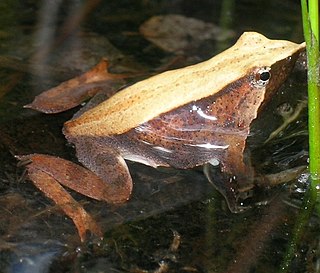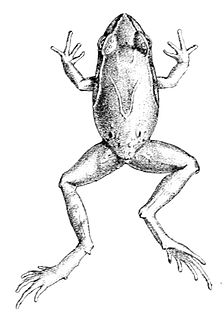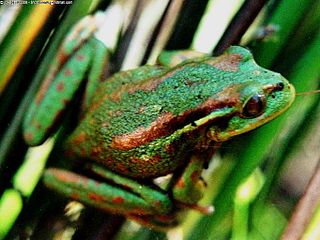 W
WAlsodes monticola is a species of frog in the family Alsodidae. It is found in southern Chile and western Santa Cruz Province, Argentina, though its presence in Argentina is disputed. Its habitat preferences are not known, but the region of the type locality has tundra and islands of Nothofagus forest.
 W
WAlsodes valdiviensis is a species of frogs in the family Alsodidae. It is endemic to Chile and only known from its type locality, Cerro Mirador in the Cordillera Pelada, Valdivia Province. The specific name refers to this province.
 W
WAtelognathus patagonicus is a species of frog in the family Batrachylidae. It is endemic to the volcanic tablelands of Neuquén Province, western Argentina. Its common name is Patagonia frog. Its natural habitats are permanent lagoons surrounded by steppe and/or semidesert. They are mostly aquatic but can also be found in the vegetation surrounding the lagoons. Breeding takes place in water.
 W
W, also called the southern Darwin's frog, is a rhinodermatid frog native to the forest streams of Chile and Argentina. It was first described by the French zoologist André Marie Constant Duméril and his assistant Gabriel Bibron in 1841, and is named after Charles Darwin, who had previously discovered it in Chile during his world voyage on HMS Beagle.
 W
WEupsophus is a genus of frogs in the family Alsodidae. They are sometimes known as ground frogs. The genus is endemic to Patagonia. Eupsophus is the second most species-rich frog genera of Patagonia. These frogs are restricted to forested areas at southern latitudes.
 W
WEupsophus calcaratus is a species of frog in the family Alsodidae. It is endemic to Patagonia. It has one of the broadest distributions of any Chilean frog.
 W
WEupsophus emiliopugini is a species of frog in the family Alsodidae. It is found in the temperate Nothofagus forests of Chile between 40°50'S and 45°20'S, and in the Lago Puelo National Park, Chubut Province, Argentina. The specific name emiliopugini honors Professor Emilio Pugín, for "his contribution to knowledge of the reproductive biology and development of the Chilean frogs". Common name Emilio's ground frog has been coined for the species.
 W
WEupsophus migueli is a species of frog in the family Alsodidae. It is endemic to Chile. Its natural habitats are temperate forest and intermittent freshwater marshes. It is threatened by habitat loss.
 W
WEupsophus roseus, the rosy ground frog, is a species of frog in the family Alsodidae. It is endemic to Chile. Its natural habitats are temperate forest, rivers, swampland, and intermittent freshwater marshes. It is threatened by habitat loss.
 W
WHylorina sylvatica is a species of frog in the family Batrachylidae. It is monotypic within the genus Hylorina. It is found in Argentina and Chile. This species is endemic to the austral Nothofagus forests of Chile and Argentina with a narrow distribution along the eastern slopes of the Andes.
 W
WNannophryne variegata, known also as the Eden Harbour toad or Patagonian toad, is a species of toad in the family Bufonidae. It is found in southern Argentina and Chile. There is also a record from Peru, but this requires confirmation given its great geographic and ecological isolation. It occurs in Tierra del Fuego south to 53°S, making it the southernmost amphibian in the world, a record shared with Batrachyla antartandica.
 W
WPleurodema thaul is a species of frog in the family Leptodactylidae. It is found in Argentina and Chile. Its natural habitats are subantarctic forests, temperate forests, temperate shrubland, temperate grassland, rivers, intermittent rivers, swamps, freshwater lakes, intermittent freshwater lakes, freshwater marshes, intermittent freshwater marshes, pastureland, plantations, rural gardens, urban areas, water storage areas, ponds, open excavations, sewage treatment areas, irrigated land, seasonally flooded agricultural land, and introduced vegetation. It is threatened by habitat loss.